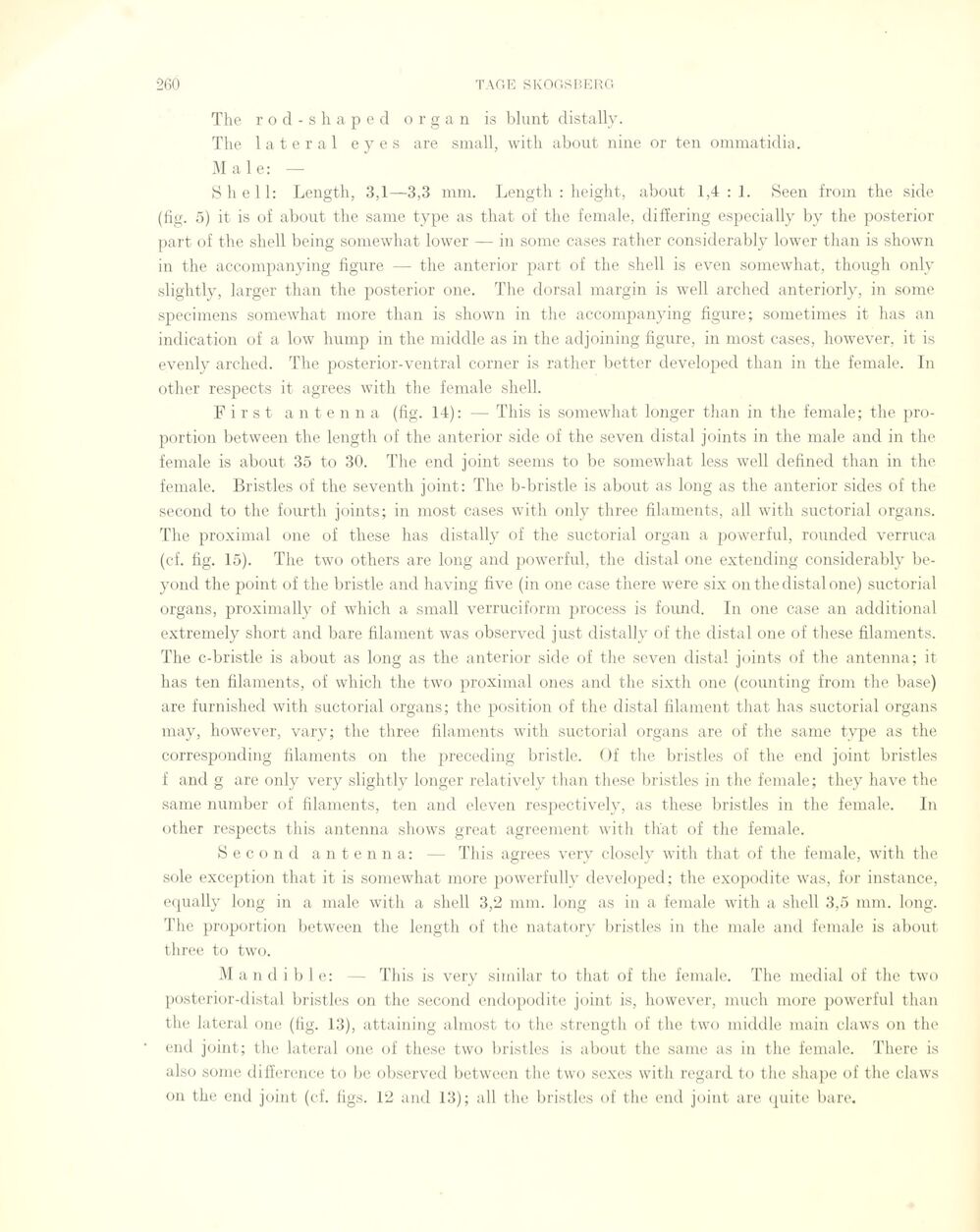
Full resolution (JPEG) - On this page / på denna sida - Sidor ...

<< prev. page << föreg. sida << >> nästa sida >> next page >>
Below is the raw OCR text
from the above scanned image.
Do you see an error? Proofread the page now!
Här nedan syns maskintolkade texten från faksimilbilden ovan.
Ser du något fel? Korrekturläs sidan nu!
This page has never been proofread. / Denna sida har aldrig korrekturlästs.
The r o cl- s haped organ is blunt distally.
The lateral eyes are small, with about nine or ten ommatidia.
Male: —
Shell: Length, 3,1—3,3 mm. Length : lieight, about 1,4:1. Seen from the side
(fig. 5) it is of about the same type as that of the female, differing especially by the posterior
part of the shell being somewhat lower — in some cases rather considerably lower than is shown
in the accompanying figure — the anterior part of the shell is even somewhat, though only
slightly, larger than the posterior one. The dorsal margin is well arched anteriorly, in some
specimens somewhat more than is shown in the accompanying figure; sometimes it has an
indication of a low hump in the middle as in the adjoining figure, in most cases, however, it is
evenly arched. The posterior-ventral corner is rather better developed than in the female. In
other respects it agrees with the female shell.
First antenna (fig. 14): — This is somewhat longer than in the female; the
proportion between the length of the anterior side of the seven distal joints in the male and in the
female is about 35 to 30. The end joint seems to be somewhat less well defined than in the
female. Bristles of the seventh joint: The b-bristle is about as long as the anterior sides of the
second to the fourth joints; in most cases with only three filaments, all with suctorial organs.
The proximal one of these has distally of the suctorial organ a powerful, rounded verruca
(cf. fig. 15). The two others are long and powerful, the distal one extending considerably
be-yond the point of the bristle and having five (in one case there were six on the distal one) suctorial
organs, proximally of which a small verruciform process is found. In one case an additional
extremely short and bare filament was observed just distally of the distal one of these filaments.
The c-bristle is about as long as the anterior side of the seven distal joints of the antenna; it
has ten filaments, of which the two proximal ones and the sixth one (counting from the base)
are furnishecl with suctorial organs; the position of the distal filament that has suctorial organs
may, however, vary; the three filaments with suctorial organs are of the same type as the
corresponding filaments on the preceding bristle. Of the bristles of the end joint bristles
f and g are only very slightly longer relatively than these bristles in the female; they have the
same number of filaments, ten and eleven respectively, as these bristles in the female. In
other respects this antenna shows great agreement with that of the female.
Second antenna: — This agrees very closely with that of the female, with the
sole exception that it is somewhat more powerfully developed; the exopodite was, for instance,
equally long in a male with a shell 3,2 mm. long as in a female with a shell 3,5 mm. long.
The proportion between the length of the natatory bristles in the male and female is about
three to two.
M a n d i b 1 e: — This is very similar to that of the female. The medial of the two
posterior-distal bristles on the second endopodite joint is, however, much more powerful than
the lateral one (fig. 13), attaining almost to the strength of the two middle main claws on the
end joint; the lateral one of these two bristlcs is about the same as in the female. There is
also some difference to be observed between the two sexes with regard to the shape of the claws
on the end joint (cf. figs. 12 and 13); all the bristles of the end joint are quite bare.
<< prev. page << föreg. sida << >> nästa sida >> next page >>